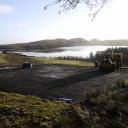
We had built a house.
A few final jobs were completed following the last blog entry.
I order 20 tonnes of gravel from a quarry on Skye and then barrowed it down the access and spread it around the house.
I also had enough to put some at the top of the access as well and fill a couple of bulk bags.
The last job for the joiner was fitting the downpipes. We used the cast iron effect ones as these provide a bit more of a decorative look compared to the standard glossy pipes.
We seeded the ground at the start of lockdown and now after a summer of growing the grass is coming on nicely. The grass seed cost very little money. It cost us around £15 to do all around the house.
We are pleased with how the house fits into its surroundings.
Our pallet wood shelter was finished and I’m currently building up the wood stocks.
I am also storing fresh cut wood for the future years. These old CUPA slates crates are useful for this.
As we are now heading into colder times of the year, we have had an opportunity to have a few burns from the stove.
I’m really pleased with how well it is performing. The stove is bang in the middle of house surrounded by thick concrete block with a lime render. It heats the entire house and the increase in room temperature can be felt twelve hours or so after the last log goes on.
I wouldn’t however recommend fitting a stove in a self-build unless you put some serious planning into how you will actually use it. Even a small stove could easily over power the heating need for a living room.
Solar gains produce our base heating, keeping the temperatures to around 20c and the daily electricity usage at 10kw.
We don’t have any underflooring heating or radiators. If we reach a long cold spot and need a quick boost, I plan to wheel out an oil electric heater or use the towel heaters.
.
What’s next. I need to crunch the final numbers. I also need to put a final layer on the access road but might put this off until the winter.
Thanks for reading.
- Read more...
- 16 comments
- 2768 views

